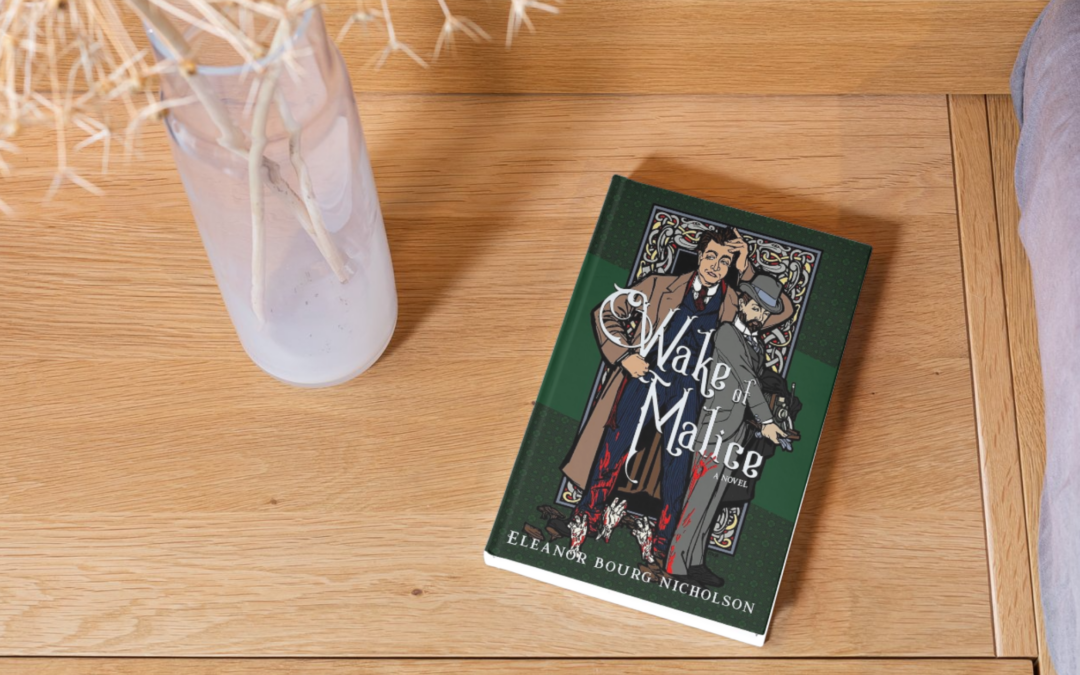Book Review: Wake of Malice by Eleanor Bourg Nicholson
There’s a lot of great Catholic fiction being published these days. One interesting work I was privileged to dive into recently was Eleanor Bourg Nicholson’s Wake of Malice (Chrism Press, 2024). Eleanor is a colleague of mine, and she’d told me about this project some time ago. I was quite interested from the get-go. I was working on my history text, The Saga of Ireland (Cruachan Hill Press, 2024), and Eleanor told me she, too, was working on a manuscript about Ireland. But whereas my book was simple history, she described hers to me as a hodgepodge of mystery, horror, comedy, and fantasy. I admit I had a difficult time envisioning what she meant by that description, but it intrigued me, and I asked to take a look at it when it came out.
Discovering The Wake of Malice
A few months later, I received a copy of The Wake of Malice in my mailbox. Right off, I was delighted by the whimsical, vintage cover art by Matthew Alderman, whose distinctive style I have always admired. Unfortunately, I couldn’t get beyond the cover because I had so many other books to review that it sat in a pile on my counter for six months.
I finally was able to dig into Wake of Malice this year, and whew, what a ride!
Gothic Horror in the Chestertonian Tradition
Wake of Malice is a mystery, so I won’t reveal much about the plot’s specifics, but I can offer some general insights. The story takes place at the turn of the 20th century in rural Ireland. Our protagonist is an Irish ex-pat named Hugh Buckley who has been working as a reporter in London. Buckley is a lapsed Catholic who has come to England to escape a troubled past. Still, a sensational murder-mystery in the obscure town of Doolin, Ireland, draws Buckley back to his homeland to investigate.
Buckley travels to Doolin accompanied by his obnoxious Protestant photographer, Frederick Jones. His arrival quickly entangles him in parish politics and occult practices. However, he receives help from Father Thomas Edmund Gilroy, an English Dominican friar. Fr. Gilroy aids him in solving the mystery while guiding Buckley back to his shattered faith.
The story unfolds against the backdrop of quaint Irish towns and picturesque countryside, which Nicholson describes superbly with vivid detail.
As I was reading this book, I kept coming back to the question, “What kind of book is this, even?” Eleanor had described it to me as a kind of a dry comedy murder mystery with a hint of the supernatural. It didn’t make much sense to me until I dug into the text, at which point I saw exactly what she meant. This book has a little of everything.
Wit, Whimsy, and Escalating Craziness
The humor is unrelenting, but it’s the dry, observational humor of the English sort. Eleanor and I are both successful authors in our own genres, but she writes witty banter on a level that I can only aspire to. Her writing always requires an engaged, attentive reading because every paragraph is dripping with wit. It’s all very Chestertonian.
Some supernatural elements are drawn from Irish folklore and Victorian-era Gothic horror. I don’t want to say much about this, except to note how well Eleanor Nicholson weaves it all together with other facets of the story. Wake of Malice follows a narrative structure that I call “escalating craziness.” I’m sure there’s a literary name for it, but I don’t know what it is. It is what you find in G.K. Chesterton stories, such as The Ball and the Cross or The Man Who Was Thursday. The plot feels very grounded and “real world” at the outset, but gets increasingly fantastical as the story moves along. This is paralleled in Wake of Malice by Buckley’s journey from London—a modern, industrial metropolis full of hard-nosed business people—back to rural Ireland. In this almost mystical environment, the spiritual is very real, and traditional folk-creatures still haunt the landscape.
If I had to characterize the style, I’d say it’s Gothic horror in the Chestertonian tradition, a label I don’t think Mrs. Nicholson would object to. It’s got mystery, wit, adventure, and is just a lot of fun.
Who Should Read This Book?
I will say, though, if you’re thinking about this for your kids, it’s definitely better suited for older children. The dialogue is complex and witty, and might be over the heads of younger readers. I’d say a child who can understand the original Father Brown stories will be fine.
This book was fun, whimsical, and kept me guessing throughout. I highly recommend it if you’re looking for imaginative, eccentric Catholic fiction. I commend Eleanor for weaving together so many distinct elements into an entertaining, cohesive story. As a writer, I know full well that this is not easy to do, but Eleanor Nicholson makes it look easy.
Final Thoughts and Recommendations
The Wake of Malice is available from Chrism Press. For readers who want to learn more about the author, visit Eleanor Bourg Nicholson’s website.
Eleanor is a beloved instructor of Victorian and Gothic Literature for Homeschool Connections, where she brings classic works to life for Catholic homeschool students. In addition to Wake of Malice, she has authored several other works, including the children’s book about St. Dominic, Hound of the Lord, as well as her acclaimed Gothic horror novels with a Catholic flair, Brother Wolf and A Bloody Habit. Beyond her own writing, she also serves as an editor for Ignatius Press’s Critical Editions series. Eleanor’s work beautifully blends faith, wimsey, and storytelling, offering Catholic readers a rich literary feast.
What are some of your favorite works of fiction? Join me and other homeschooling parents in the Homeschool Connections Facebook Group or in the HSC Community to continue the conversation.
This article contains affiliate links.






